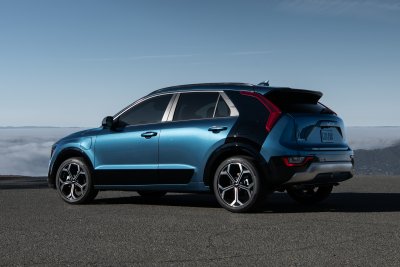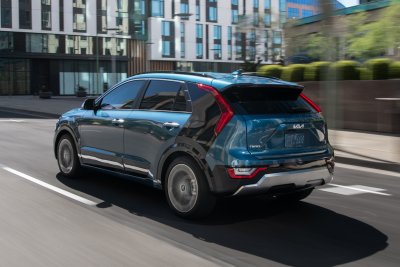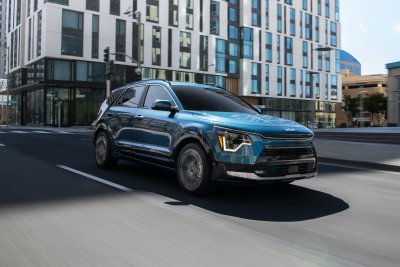The second-generation Kia Niro debuted at the New York International Auto Show in April. The small SUV now comes in hybrid, plug-in hybrid and electric versions with an incrementally bigger footprint than the outgoing model.
The exterior redesign touched almost every panel, bringing the new Niro in line with Kia's other modern SUVs. It comes with the company's tiger nose grille and upswept daytime running lights. New boomerang-shaped taillights complete the rear with a skid plate and lower bumper. The side profile impressed with a new aero blade accent towards the rear.
The interior is also new with textured surfaces on the seats and dash and modern touches from the Kia EV6. It uses animal-free textiles, and the headliner is made from recycled material. Two 10.25-inch panoramic digital screens are offered, one for the instrument cluster and one for infotainment. An 8-speaker premium sound system is optional as is front seat heat, ventilation and memory. The Niro features standard USB ports on the sides so that back-seat passengers can easily charge their devices.
With three available power options, the Kia Niro competes most closely with the new Toyota Prius ($27,450). Both are hybrid and both have plugs. The Hyundai Ioniq 5 ($41,450) is more expensive but all-electric. The Niro's clone in the Hyundai Kona is also an option at $22,140 for the base gasoline model.









The interior looks clean and modern with textures over many of the surfaces, including the comfortable and adjustable seats. Visibility is good with small A-pillars and the view out of the back is wide. The two spoke steering wheel features redundant radio controls and drive mode button.
The two screens together look excellent with bright colors and snappy changes. It's within reach and the two home screens have every control you might need. The panel below the radio is new. It's a digital screen and switches between climate and radio/mode controls. It's annoying when looking for one and finding the other, and when a knuckle accidentally grazes the switch button, and the driver ends up turning the heat up instead of the radio. After a week it gets a little easier to use.
As we said, the Niro comes in hybrid, plug-in hybrid and battery electric. The plug-in hybrid was tested here and features a 1.6-liter, four-cylinder engine with a 62-kW electric motor for a total system output of 180 horsepower and 195 pound-feet of torque. When it is connected to a Level 2 charger, the Niro PHEV can refill its 11.1-kWh lithium-ion polymer battery in under three hours. When fully charged it has an electric range of 33 miles and returns 108 miles per gallon equivalent.
The Niro PHEV only has Sport and Eco modes, which is perfect. Eco mode keeps the engine from drinking too much fuel, using the electric motor whenever possible. In Sport mode the engine stays running, and idles a little higher, to keep the battery charged for sporty maneuvers. In that mode, the Niro is fun to drive.

In Eco, it's also acceptable, and still gets moving when the pedal is floored. The Niro has regenerative brakes that aren't quite dialed it. They feel spongy, and during panic stops don't slow the vehicle down fast enough. The transition from regen to acceleration is also abrupt, almost like the brakes are sticking for a split second.
Steering is light and easy, though reasonably direct. The Niro goes where the driver points it without too much drama. However, it's not made for corner carving. It's still more fun to drive than the Prius, which is also faster than its previous models. The suspension too, is soft and easy, and with a little extra ground clearance over the average sedan, will do some light off roading without any worries.
Standard safety features include forward collision avoidance, lane keeping assist, lane following assist, which helps detect lane markings and vehicles ahead. It also comes with blind spot warnings, a driver attention warning, and rear cross traffic alert.
The 2023 Kia Niro plug-in hybrid is one of those do everything cars with space for four passengers comfortably plus their cargo. It may not be as handsome as the new Toyota Prius or the Ioniq 5 but it's also less expensive. The rugged Toyota Rav4 is also an option, the least expensive of which is $27,575. The Rav4 hybrid starts at $30,225.
Any of those are solid, efficient transportation. Of the sedans, the Toyota Prius is very good and looks great. The Toyota Rav4 should be the starting point for any SUV intenders.








